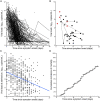Modeling SARS-CoV-2 viral kinetics and association with mortality in hospitalized patients from the French COVID cohort
- PMID: 33536313
- PMCID: PMC7929555
- DOI: 10.1073/pnas.2017962118
Modeling SARS-CoV-2 viral kinetics and association with mortality in hospitalized patients from the French COVID cohort
Abstract
The characterization of severe acute respiratory syndrome coronavirus 2 (SARS-CoV-2) viral kinetics in hospitalized patients and its association with mortality is unknown. We analyzed death and nasopharyngeal viral kinetics in 655 hospitalized patients from the prospective French COVID cohort. The model predicted a median peak viral load that coincided with symptom onset. Patients with age ≥65 y had a smaller loss rate of infected cells, leading to a delayed median time to viral clearance occurring 16 d after symptom onset as compared to 13 d in younger patients (P < 10-4). In multivariate analysis, the risk factors associated with mortality were age ≥65 y, male gender, and presence of chronic pulmonary disease (hazard ratio [HR] > 2.0). Using a joint model, viral dynamics after hospital admission was an independent predictor of mortality (HR = 1.31, P < 10-3). Finally, we used our model to simulate the effects of effective pharmacological interventions on time to viral clearance and mortality. A treatment able to reduce viral production by 90% upon hospital admission would shorten the time to viral clearance by 2.0 and 2.9 d in patients of age <65 y and ≥65 y, respectively. Assuming that the association between viral dynamics and mortality would remain similar to that observed in our population, this could translate into a reduction of mortality from 19 to 14% in patients of age ≥65 y with risk factors. Our results show that viral dynamics is associated with mortality in hospitalized patients. Strategies aiming to reduce viral load could have an effect on mortality rate in this population.
Keywords: SARS-CoV-2; mortality; viral dynamics.
Copyright © 2021 the Author(s). Published by PNAS.
Conflict of interest statement
Competing interest statement: J. Guedj has worked as a consultant for ROCHE Company.
Figures




References
-
- World Health Organization , Coronavirus disease (COVID-19) outbreak situation: Situation report. https://www.who.int/docs/default-source/coronaviruse/situation-reports/2.... Accessed 25 January 2021.
-
- Onder G., Rezza G., Brusaferro S., Case-fatality rate and characteristics of patients dying in relation to COVID-19 in Italy. JAMA 323, 1775–1776 (2020). - PubMed
Publication types
MeSH terms
Substances
LinkOut - more resources
Full Text Sources
Other Literature Sources
Medical
Miscellaneous

